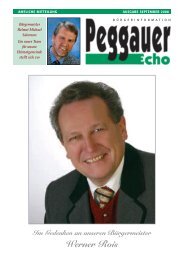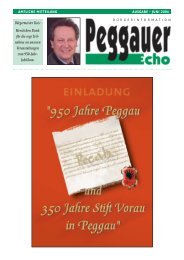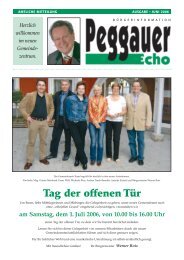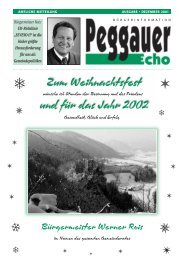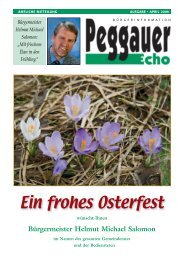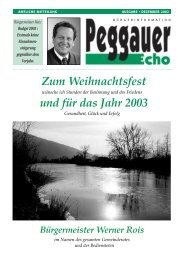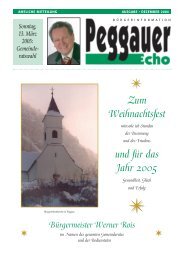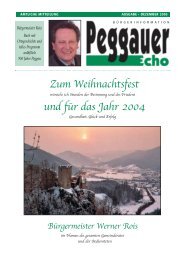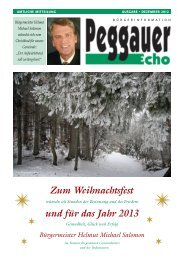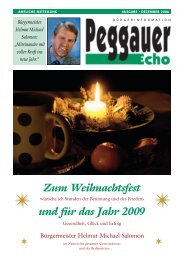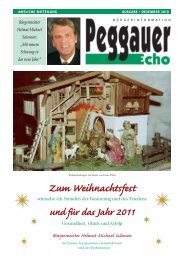Bürgermeister Helmut Michael Salomon - Marktgemeinde Peggau
Bürgermeister Helmut Michael Salomon - Marktgemeinde Peggau
Bürgermeister Helmut Michael Salomon - Marktgemeinde Peggau
Erfolgreiche ePaper selbst erstellen
Machen Sie aus Ihren PDF Publikationen ein blätterbares Flipbook mit unserer einzigartigen Google optimierten e-Paper Software.
can shelter many different species of insects (Fahrig and Jonsen 1998). Many of these are insects such aswasps, beetles, and spiders that prey on agricultural insect pests (Wathern 1977). The strips provide shelter,summer aestivation sites, over-wintering sites, and breeding areas (Bhar and Fahrig 1998). Grasslands havebeen shown to have better properties than forests for many species of insects (Sotherton 1985). Research alsoshows that native plant communities and many typical roadsides share some of the characteristics of productiveinsect habitat. Native grassland communities that are in a state of middle-succession seem to offer a higherquality habitat than mature, less diverse communities (Dyer and Landis 1997). The disturbances typical of manyroadsides provide more flowering food plants as well as open soil for some insect species, conditions thatenhance insect habitat (Wratten 1998; Jansen 1992).These studies suggest that workable criteria could be developed to identify potential roadside sites (Figure 5) forconservation, as well as maintenance practices for results that are highly site-specific. Mowing or otherdisturbance activities, usually considered negative, might be desirable if it were found to be compatible withcertain flowering, weedy plants that a desirable insect can use as habitat. Using the previous process chart(Figure 4), designers (both public and private) can determine if such an initiative is likely to succeed. Localagricultural agents and landowners could aid in identifying and characterizing the nature of the issues. Landmanagement practices can be identified. Pest and beneficial insect populations can be explored in vegetationcommunities of the area. Once the nature of the insect populations is described, an appropriate plant pallet canbe developed. The type of insects in question will determine the optimal time for appropriate managementpractices. Fundamental criteria using simple measurements of vegetation structure and diversity (particularly thepresence of potential food source plants) would be needed.The entire process suggests that a multi-disciplinary team will be needed, significant fieldwork may be required,and meetings with landowners must be held. It has been the author’s experience that these are requisite aspectsof a viable program if it is to endure and actually make a meaningful contribution to the environmental health ofour communities.ConclusionsImproving the ecological fit of our highways includes and requires developing meaningful ecological goals for theroadside. This paper proposes that more effort needs to be made towards creating measurable connections toregional ecological issues, and then expressing those in terms of accomplishable tasks. Looking outside the rightof-wayis the best way to connect to meaningful ecological issues. It also implies a connection to the culture andcommunity of the region, as well as to other agencies and organizations.Biographical Sketch: Jim Schutt is an Assistant Research Scientist in the Environmental Management Program of the TexasTransportation Institute at Texas A&M University. He is a Registered Landscape Architect (TAMU, 1981) and holds a MS Degree in RangeScience (TAMU, 2000). Since 1987 he has worked closely with the Texas Department of Transportation on aesthetics planning, roadsidedesign, restoration, and maintenance planning. He is a member of the National Roadside Vegetation Management Association and serveson the Maintenance Committee of the Transportation Research Board. He is a member of the board of the Native Prairies Association ofTexas.ReferencesBassett, K. (1999). Managing Roadsides Naturally. Native Plants, a Quarterly Publication of the Lady BirdJohnson Wildflower Center. 16: 5-7.Bennet, A. F. (1991). Roads, Roadsides and Wildlife Conservation: A Review. Nature Conservation 2: The Roleof Corridors. D. A. Saunders and R. J. Hobbs. Como, Western Australia, Australia, Surrey Beatty & Sons:99-118.Bennet, A. F., et al. (1994). "Corridor use and the elements of corridor quality - Chipmunks and fencerows in afarmland mosaic." Biological Conservation 68(2): 155-165.Bhar, R. and L. Fahrig (1998). "Local vs. landscape effects of woody field borders as barriers to crop pestmanagement." Conservation Ecology 2(2): 3.Dyer, L. E. and D. A. Landis (1997). "Influence of noncrop habitats on the distribution of Eriborus terebrans(Hymenoptera: Ichneumonidae) in cornfields." Biological Control 26: 924-932.Evink, G. (1998). Ecological Highways. International Conference on Wildlife Ecology and Transportation, FortMeyers, Florida, Federal Highway Administration.ICOET 2001 Proceedings 327 A Time for Action






